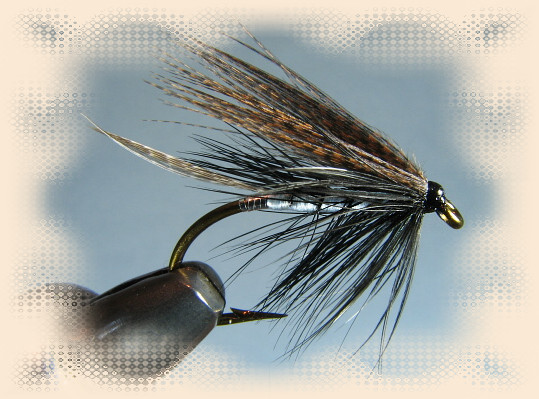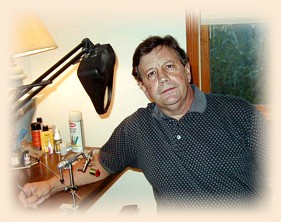Molechunkemunk, or crooked water, was the Abenaki Indian name for what is now
Upper Richardson lake, found in the Rangeley Region of Maine. I must note here that spelling
was not yet an exact science, Webster's dictionary not available everywhere yet, and the lake
is referred to as Molechunkamunk, with an "a", by some authors of the day. I have no way of knowing
which spelling is correct, perhaps both are. It is located South-West of Mooselookmeguntic and
is connected to it by a straight of water, in the center of which is Upper Dam. This straight was very
dangerous in the early days, and quite harrowing to pass through. There is a fly named for Upper Richardson
Lake as well, called, surprisingly, the Richardson. It sports a bronze mallard wing as well.

The fly fishermen who frequented the Rangeley Region in the late 1800s were upper class
gentlemen, usually well-heeled, who would take trips lasting anywhere from two weeks to all
summer long. They would hire guides, and stay at various camps around the lakes for periods
of time, depending on the fishing. I wouldn't exactly call their wilderness experiences roughing it,
the guides doing most of the work, portaging the canoes, cleaning the fish, rowing the boats,
etc. At a dollar a day they were worth their weight in gold. Here is an artist's rendering of a
typical camp on Molechunkemunk found in Capt. Charles A. J. Farrar's Camp
Life in the Wilderness:

The fishing was good. Take a look at this page from Farrar's Through the Wilds:

One of the gentlemen who frequented this area and
others in the region was Mr. John W. Webster of Waterbury,
Connecticut. He was one of the Maine correspondents found
in Mary Orvis Marbury's Favorite Flies.
He made over thirty trips to the Region, spending several
weeks there each summer. It is noteworthy that he was
the nephew of Noah Webster, of dictionary fame. When
he set out to get his law degree he went to Noah to borrow
some money for tuition. Noah told him, in so many words, to
take a hike, that he had a good trade as a machinist
and he should be happy with his lot. Undeterred, John Webster
went on to become a highly esteemed judge. He seemed
to harbor no ill feelings toward his uncle, and was
instrumental in distributing many volumes of the "great dictionary"
around Connecticut. From all the spelling variations I've found
in these old texts, I can only think that this was a good thing.
John W.Webster was so highly regarded that a fly was named
in his honor, one that he claimed was "nearly perfect, and effective
on any waters". Mr. Webster's fly shown below, along with the
recipes for both the Molechunkemunk, Richardson
and Webster.

Webster
Tip: Silver tinsel
Tail: Golden pheasant crest
Ribbing: Silver tinsel
Body: Black floss
Hackle: Deep brown hen
Wing: Fine mottled guinea
Molechunkemunk
Ribbing: Silver tinsel
Body: Orange floss
Hackle: Furnace
Wing: Bronze mallard
Richardson
Credits: Camp Life in the Wilderness by
Capt. Charles A. J. Farrar; Through the Wilds by
Capt. Charles A. J. Farrar; Flies by J. Edson
Leonard; Trout by Ray Bergman; Carrie
Stevens by Graydon R. Hilyard; Outing Volume Vlll
Issue 3 June 1886 "Trout Fishing In Maine" by Ripley Hitchcock;
Favorite Flies and Their Histories by Mary Orvis Marbury;
Noah Webster, article from Connecticut Magazine by
Wilbur Webster Judd; ~ EA
About Eric:
 Eric lives in Delaware, Ohio and fishes for brown trout in
the Mad River, a beautiful spring creek. More of his flies
are on display here:
Traditionalflies.com -- Classic salmon and
trout flies of Europe and the Americas.
Eric lives in Delaware, Ohio and fishes for brown trout in
the Mad River, a beautiful spring creek. More of his flies
are on display here:
Traditionalflies.com -- Classic salmon and
trout flies of Europe and the Americas.
|






 Eric lives in Delaware, Ohio and fishes for brown trout in
the Mad River, a beautiful spring creek. More of his flies
are on display here:
Traditionalflies.com -- Classic salmon and
trout flies of Europe and the Americas.
Eric lives in Delaware, Ohio and fishes for brown trout in
the Mad River, a beautiful spring creek. More of his flies
are on display here:
Traditionalflies.com -- Classic salmon and
trout flies of Europe and the Americas.